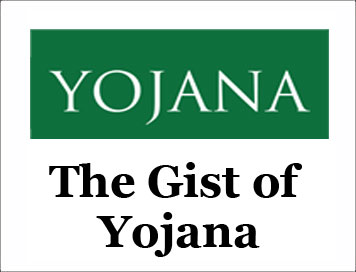(HOT) UPSC Current Affairs 2025 PDF
NEW! The Gist (NOV-2025) | E-BOOKS
(GIST OF YOJANA) Panchayati Raj institutions: Empowering Rural women
GIST OF YOJANA : Panchayati Raj institutions: Empowering Rural women
JULY-2025
Panchayati Raj institutions: Empowering Rural women
Context:
Women constitute about half of the world’s population. It is estimated that they have only l/10th of the global income, own l/100th of the means of production, nearly 70 per cent of the women live below the poverty line, and about two-thirds of them lack access to basic education. Empowerment of women is a necessary basic condition for socio-economic development of any society.
Background:
Panchayats have been the backbone of grassroots democracy in the Indian villages since its beginning. Gandhiji had aptly favoured the Panchayati Raj, and this got translated with the passage of the Constitution (73rd Amendment) Act,1992(or simply the Panchayati Raj Act], which introduced the three-tier Panchayati Raj System to ensure people’s participation in rural reconstruction in general and that of women in particular. It came into force with effect from 24 April 1993.
Provisions for Women in the Act
-
The Act provides for the reservation of not less than one-third of the total number of seats for women (including the number of seats reserved for the SCs, STs and OBCs].
-
Further, not less than one-third of the total number of offices of chairpersons and members in the Panchayats at each level shall be reserved for women. This would be rotated among different Panchayats at each level.
Participation of Women in Panchayats
-
In 1992, when the 73rd and 74th Constitutional Amendments introduced local self-governance, it was an unparalleled step to consciously empower women as decision-makers with l/3rd of the seats reserved for women. Today, 14 states have 50 per cent-58 per cent representation of women in Panchayati Raj Institutions. Jharkhand leads the way with 59 per cent, closely followed by Rajasthan and Uttarakhand.
-
The Act provides for the reservation of not less than one-third of the total number of seats for women.
-
It is an attempt to ensure greater participation of women in the election process directly and indirectly. It (PRI] is the nursery of creating women politicians for national politics. After General Election of panchayat in 2015, women constitute more than 33 per cent of the Total Elected Representatives.
Difficulties faced by women elected representative in PRs
-
Women act as proxies for men.
-
Husband’s intervention of elected woman in her functioning.
-
Lack of political awareness among the women in rural areas.
-
Negative public opinion regarding women’s leadership capacity.
-
Illiteracy or low standards of education among the women in rural areas is a stumbling block.
-
Lack of training courses, especially for women representatives at their district level.
-
Dominance of elected male members of the Panchayat.
-
Politically motivated violence against women has seen an increase.
Suggestions for Effective Participation of Women in Panchayati Raj System
-
Elections should be conducted in a free and fair manner.
-
In rural areas, due to illiteracy or low literacy levels, political awareness among the women is negligible. The government and local administration play a crucial role in educating women about political issues and fostering awareness to empower their participation.
-
Special training and refresher courses for women representatives should be conducted from time to time at their block and district level. It gives them confidence and creates political awareness, power and knowledge of various programmes/activities of development.
-
The government should make special provisions for the women representatives and give them more powers as compared to their male counterparts and educate them about their powers. It helps them to work efficiently and effectively.
-
There should be a provision to give honour and more financial rewards schemes to the best women members for their exemplary works.
Way ahead:
-
The establishment of PRIs in our country provides women with the opportunity to demonstrate their capabilities as effective administrators, decisive policymakers, and strong leaders. The 73rd Constitutional Amendment Act, 1992, is a milestone in this regard. It provides women a chance to come forward.
-
This experiment is proving to be a big success, particularly by providing an opportunity for women to come out of their houses and participate in the administrative and political field. Despite its implementation, the system in many areas has been dominated by elite groups.
-
The government should provide extra financial, administrative or political assistance to women for the success of the provision of the amendment. The government should actively support research and development to enhance the effective implementation of the 73rd Amendment’s provisions.
Conclusion:
Through PRIs, women can help in eradicating a number of evils like alcoholism, child marriages, the dowry system, violence against women, untouchability, class conflicts, etc. With women’s participation in PRIs, rural women are increasingly aspiring to engage in economically productive activities. Many Self-Help Groups have been formed by women in rural areas, and various development schemes like Mahatma Gandhi National Rural Employment Guarantee Act (MGNREGA) are empowering them economically by providing them some source of income.
CLICK HERE TO DOWNLOAD FULL PDF
CLICK HERE TO DOWNLOAD UPSC E-BOOKS
Study Material for UPSC General Studies Pre Cum Mains
Get The Gist 1 Year Subscription Online
Click Here to Download More Free Sample Material
<<Go Back To Main Page
Courtesy: Yojana



